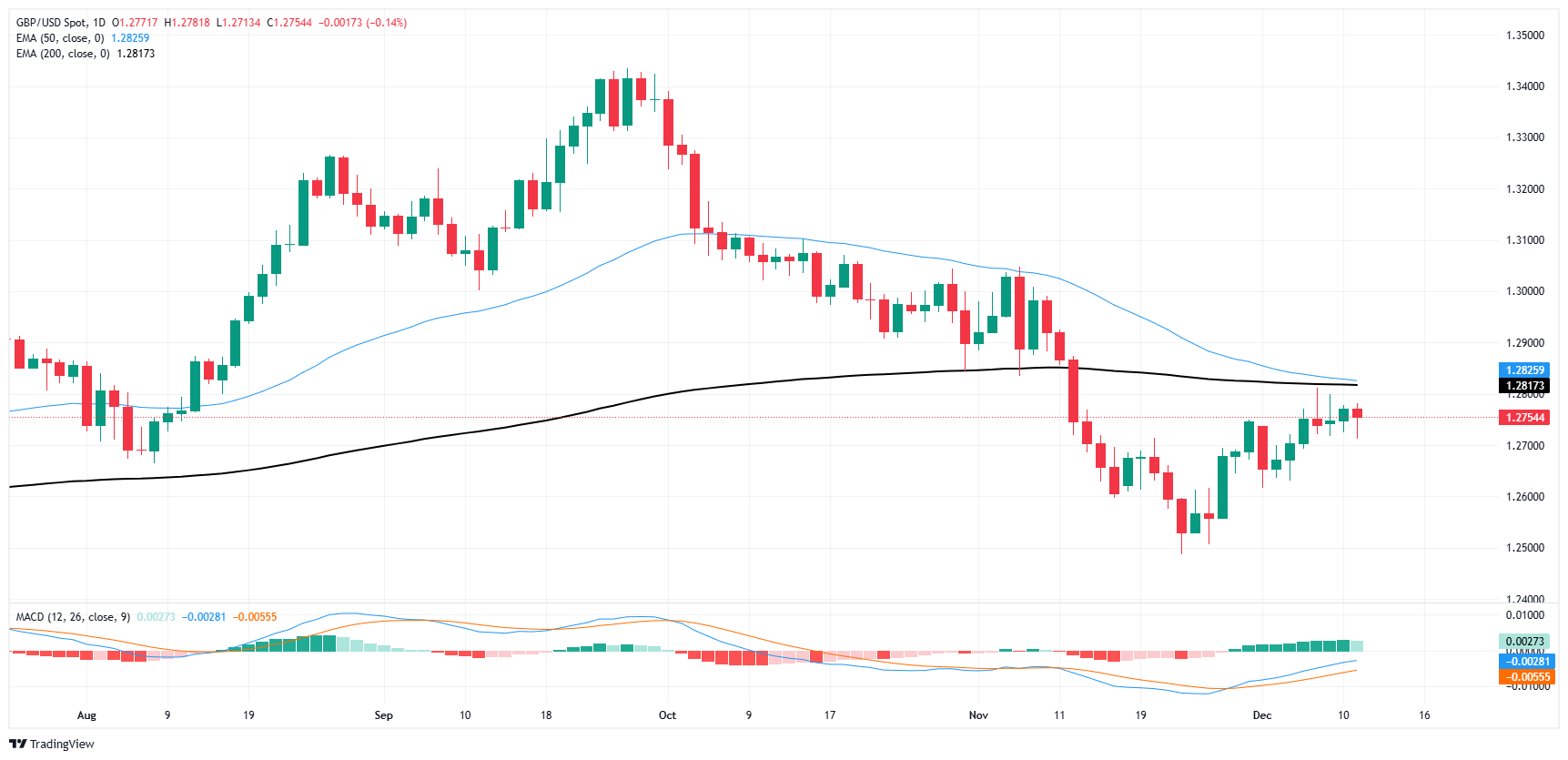GBP/USD sticks to midrange post-US CPI inflation
- GBP/USD got hung up on 1.27509 on Wednesday.
- US CPI inflation ticked higher, but met expectations.
- Traders will now pivot to US PPI inflation figures due on Thursday.
GBP/USD went nowhere quickly on Wednesday, churning near 1.2750 after US Consumer Price Index (CPI) figures for November widely met median market expectations. The rest of the week remains tepid on the UK side of the economic calendar, leaving Cable traders to face US Producer Price Index (PPI) numbers on Thursday.
US CPI inflation rose slightly for the year ended in November with headline CPI inflation ticking up to 2.7% YoY from 2.6%, while core CPI inflation held steady at 3.3% YoY. Monthly headline CPI inflation also rose in November, climbing to 0.3% MoM from October’s 0.2%. Despite the overall upswing in main inflation figures, Wednesday’s CPI print was broadly in line with forecasts, keeping investor sentiment tepid.
According to the CME’s FedWatch Tool, rate traders are now pricing in 95% odds of a 25 bps rate cut when the Fed convenes for its last rate call on December 18. Despite the near-term uptick in CPI inflation, investors have decided that the wiggle in reported figures isn’t enough to push the Fed away from delivering one last quarter-point cut to wrap up 2024.
US PPI inflation drops on Thursday, and markets are expecting a similar showing to this week’s CPI print: producer-level inflation is expected to tick higher on the front end of the curve, but expected to remain to close to recent levels overall. Core PPI is forecast to rise to 3.2% YoY, up slightly from the previous period’s 3.1%.
GBP/USD price forecast
GBP/USD is battling near-term chart churn near the 1.2800 handle, with the pair suspending in a dead zone just south of the 200-day Exponential Moving Average (EMA) near 1.2830. Price action has made a slow, trudging recovery after bottoming out near 1.2500 in late November, but bullish momentum is running into trouble and another leg lower could be chalked into the chart if the 200-day EMA stops being a target and becomes a hard technical barrier.
GBP/USD daily chart
Pound Sterling FAQs
The Pound Sterling (GBP) is the oldest currency in the world (886 AD) and the official currency of the United Kingdom. It is the fourth most traded unit for foreign exchange (FX) in the world, accounting for 12% of all transactions, averaging $630 billion a day, according to 2022 data. Its key trading pairs are GBP/USD, also known as ‘Cable’, which accounts for 11% of FX, GBP/JPY, or the ‘Dragon’ as it is known by traders (3%), and EUR/GBP (2%). The Pound Sterling is issued by the Bank of England (BoE).
The single most important factor influencing the value of the Pound Sterling is monetary policy decided by the Bank of England. The BoE bases its decisions on whether it has achieved its primary goal of “price stability” – a steady inflation rate of around 2%. Its primary tool for achieving this is the adjustment of interest rates. When inflation is too high, the BoE will try to rein it in by raising interest rates, making it more expensive for people and businesses to access credit. This is generally positive for GBP, as higher interest rates make the UK a more attractive place for global investors to park their money. When inflation falls too low it is a sign economic growth is slowing. In this scenario, the BoE will consider lowering interest rates to cheapen credit so businesses will borrow more to invest in growth-generating projects.
Data releases gauge the health of the economy and can impact the value of the Pound Sterling. Indicators such as GDP, Manufacturing and Services PMIs, and employment can all influence the direction of the GBP. A strong economy is good for Sterling. Not only does it attract more foreign investment but it may encourage the BoE to put up interest rates, which will directly strengthen GBP. Otherwise, if economic data is weak, the Pound Sterling is likely to fall.
Another significant data release for the Pound Sterling is the Trade Balance. This indicator measures the difference between what a country earns from its exports and what it spends on imports over a given period. If a country produces highly sought-after exports, its currency will benefit purely from the extra demand created from foreign buyers seeking to purchase these goods. Therefore, a positive net Trade Balance strengthens a currency and vice versa for a negative balance.


